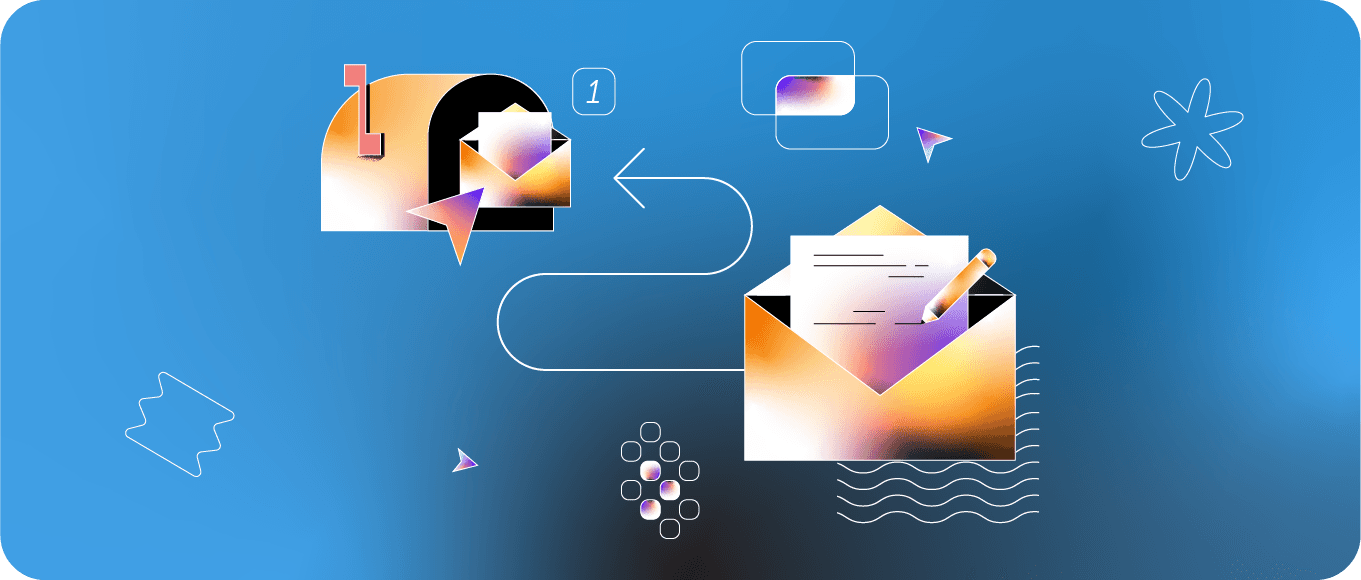
The initial email makes a polite introduction when you’re trying to get something done, whether it’s closing a deal or collecting information. And while it's important, it isn’t the whole story.
Recommended: Email Address Generator
That’s where follow-up emails come into the picture. You can send them to:
- Remind the person you’re communicating with about your request
- Politely nudge them into action
- Show them you’re invested in the outcome
Sending a follow-up email is the difference between casually mentioning you’d like to grab coffee sometime and showing someone you want to take them out on a date.
Just the first follow-up email can
increase your reply rate by 40%!
To succeed in marketing, you need to know how to write a follow-up email that connects the
initial opportunity with actual results—and we'll show you how.
But we won't merely share follow-up
email marketing best practices and templates; we'll also teach you the critical steps to writing a successful follow-up email from scratch.
Let's begin.
Step 1: Decide The Objective Of Your Follow-Up Email
Determine what you wish to achieve with the follow-up email. What’s the end objective/goal of your message? What action do you want the recipient to take?
Some ideas include:
- Reminding them to schedule a meeting
- Booking a demo
- Signing up for a trial
- Closing a sale
- Building strong client relationships
- Catching up with clients
Clarifying the objective will help you write the message with a clear purpose and incorporate a suitable call-to-action (CTA). You can also add some immediate value depending on
your specific objective, making the recipient more likely to respond.
Step 2: Write A Compelling Subject Line
No— “Follow-up” or “I'm waiting for your reply…” aren't good email subject lines.
They're likely to be ignored and cause the reader to feel you’re pointing blame because they didn’t answer, which may lower their interest in reading your email.
The best email subject lines get the recipient to open and read the message. Write a subject line relevant to your email’s purpose or objective. Think about your email and the action you want the recipient to take.
Here are some more tips for writing strong follow-up subject lines:
- Use action-oriented language. Add power words and concrete numbers to inspire action. For example, “Meeting Request: [Date & Time].” Note that certain words like “Free“ and “Money“ trigger spam filters, so it’s best to avoid them.
- Avoid clickbait. Even if clickbait gets the recipient to open your email, they may end up ignoring it or, worse, deleting it. Use direct and straightforward language that tells the recipient what to expect after opening your email. For example, “[Recipient Name], let’s schedule a [Meeting/Call] to discuss [Topic].”
- Keep it short. With 56% of emails read on mobile phones, it’s better to write subject lines about five words in length. For example, “Next Steps: [Project/Opportunity].
- Create a sense of urgency. Use language that implies a sense of urgency without appearing pushy or aggressive. For example, “[Recipient Name], Time-Sensitive: [Topic].”
- Be personal. If you know the recipient’s name or a mutual contact, use it to make the email more personal and relevant. For example, “Don't Miss Out on This, [Recipient Name].”
- Highlight the benefit. Mention how your message will benefit the recipient to catch their attention. For example, “Maximizing ROI: Proposal to 3x Your Revenue.“
Template Example
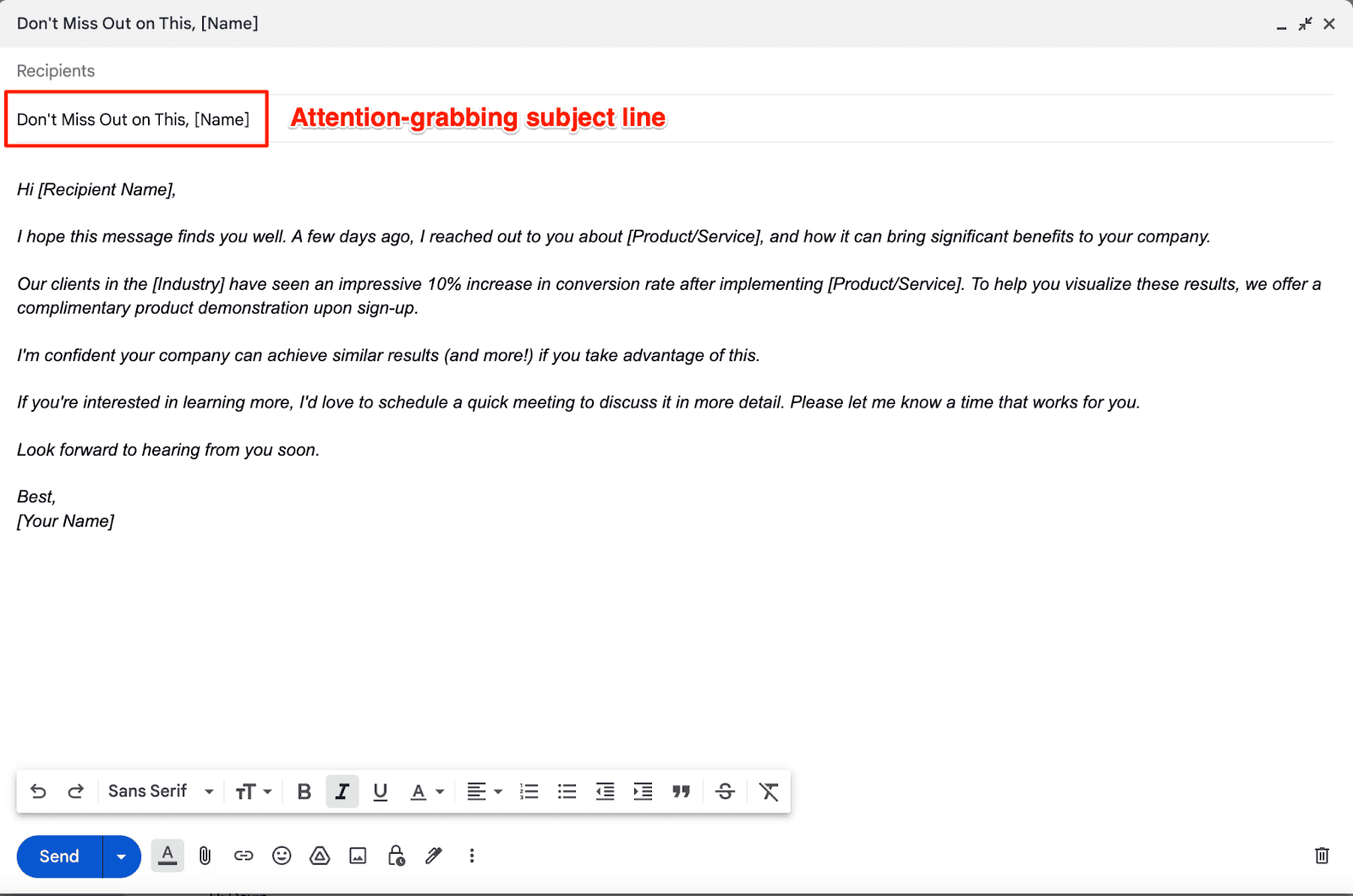
Step 3: Provide Context At The Beginning
Give the recipient a refresher about your initial email. Be sure to provide enough context so they know who you are and what you’re following up about without having to hunt for the first email(s).
Why is this important?
Today, one's inbox is flooded with way too many emails. To make your follow-up email stand out, it's crucial to include an identifier that reminds the recipient you've contacted them before. This makes it easier for the recipient to find your email amongst the many they receive and shows your persistence and determination.
The following are some strong openers you can try:
- "Remember when we talked about [Topic], I have great news, and I can't wait to share it with you. Can we set a date for a call?"
- "I have been working on an exciting project that I believe will be perfect for you. I'd love to schedule a meeting to share more details about it."
- "It was great connecting with you at [Event/Place]. I wanted to follow up on our conversation about [Topic]."
- "I'm reaching out to check in and see if there have been any updates on [Topic]."
- "I wanted to remind you about [topic] and see if there's any action we can take next."
- Our mutual friend, [Friend Name], suggested I reach out to you about [Topic].
Template Example
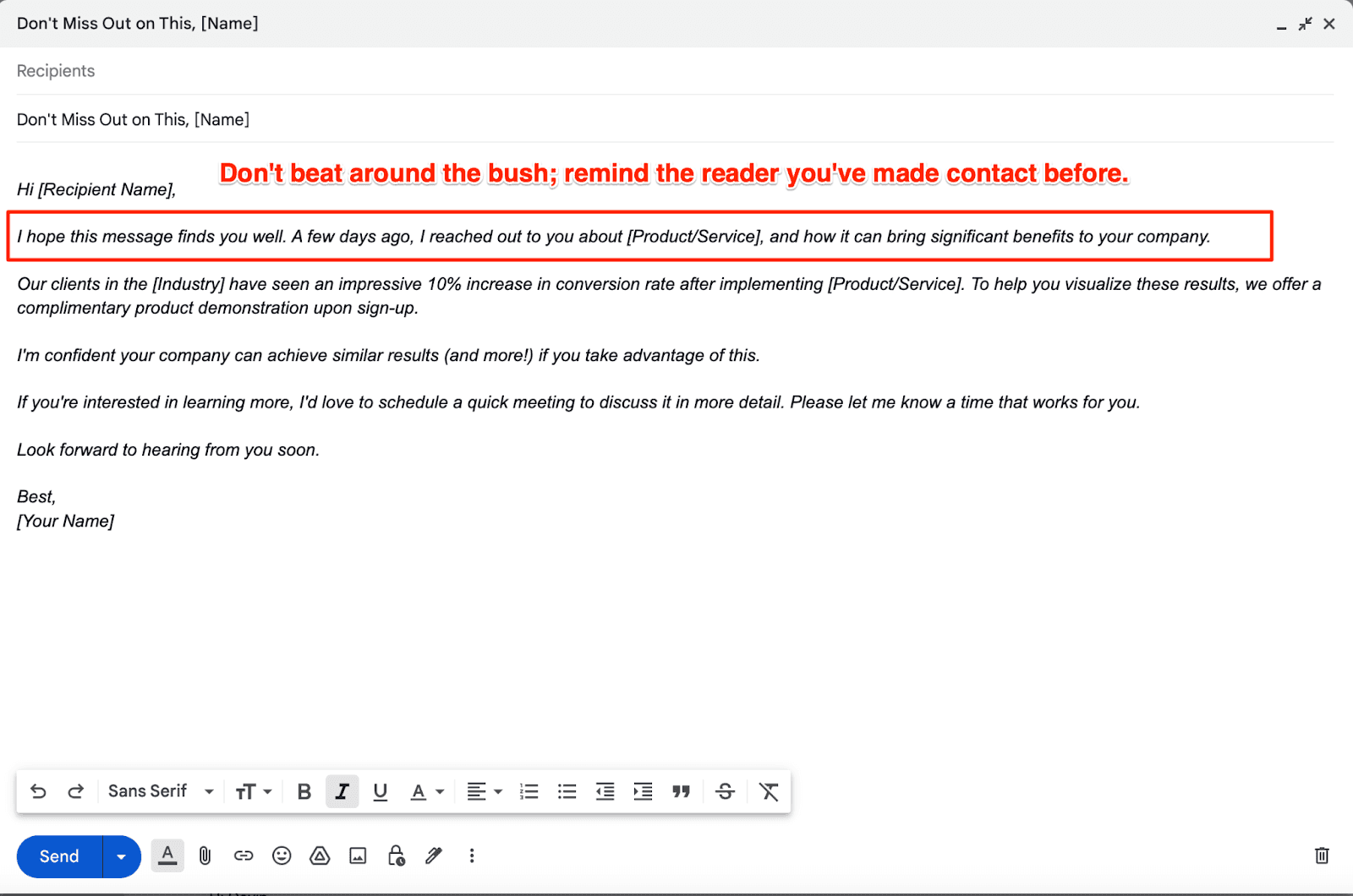
Step 4: Write The Body Of Your Follow-Up Email
You may have received or sent (don’t worry, we won’t judge) one-line follow-up emails like this one:

As you can see, compared to the previous follow-up emails we shared, this one doesn’t provide any additional information to
spark the recipient’s interest and get them to reply. It’s lazy.
Think about it: would you reply if you have hundreds of other things to do on your to-do list?
Exactly.
That’s why you should follow up an engaging opener with an equally amazing, value-packed email body.
Be specific and straightforward about
your intentions so the reader doesn’t feel you’re wasting their time. Then use the following ideas to add value to your message:
- Share customer testimonials from other clients in the same industry/business as the recipient
- Case studies
- Blog posts
- Social proof
- Webinar
- Solutions for pain points
- Exclusive discounts and offers
- E-books
- How-to videos
- Extended free trial
Ensure the idea you choose is relevant to the recipient, where they view it as an asset.
You can also ask the recipient to share their opinions and views. For example, questions like “Does the pricing work for you?” and “Which features are the most important to you in [Product Type]“ open the lines of communication and give you more insight into the reader’s mind.
Template Example

Step 5: Deliver Next Steps With A Call-to-Action
Remember the objective you determined in Step 1? Write a persuasive CTA around it, and add it at the end of your follow-up email.
The recipient should know what to do after reading your message. If you don’t guide them, it’s highly unlikely they will get back to you.
Take this follow-up email, for example.

The sender makes it easy for the reader to respond and leaves a communication line open, which helps you stay connected and build relationships.
Here are some tips you can use to write similarly strong CTAs:
- Keep it simple: Make sure your CTA is easy to follow, ideally with just one click or clear instructions on what to do next. Use language that compels them to act, like "Sign up now" or "Book your meeting."
- Add some urgency but be straightforward: Tell them exactly what you want them to do, such as "Schedule a call to learn more about our services" instead of just "Learn more." But make them feel like they need to act fast by using phrases like "Limited spots available" or "Don't miss out."
- Make it visible and experiment. Use a contrasting color for your CTA button to make it stand out from the rest of the email. We recommend using A/B testing to try different CTA phrases and formats to see which works best for your target audience.
- Show the value: Explain how your recipient will benefit from the action you suggest, whether it's time saved, money earned, or problem solved.
Template Example
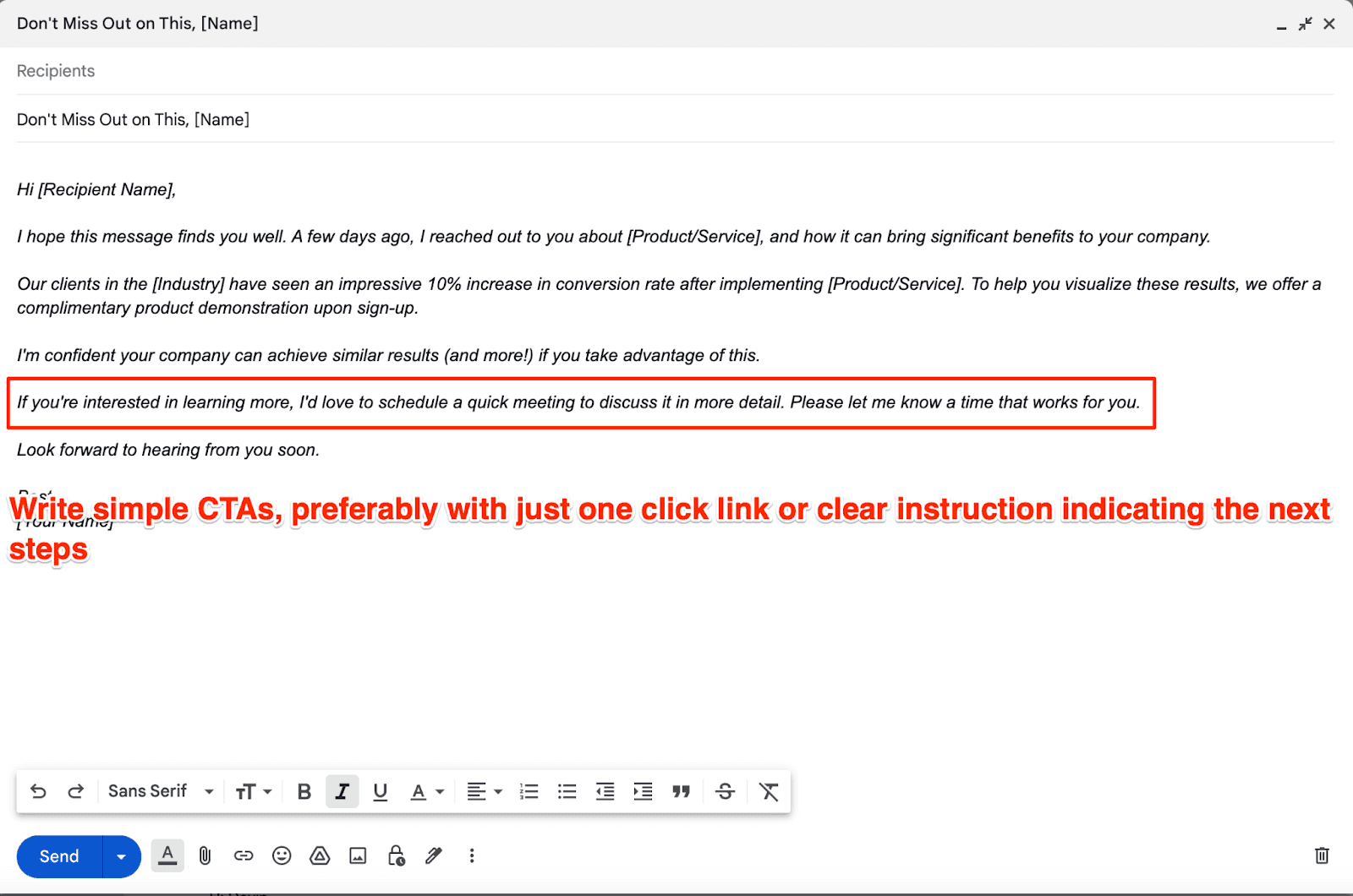
Step 6: Close & Send The Follow-Up Email
Close your email politely, preferably in a way that reflects your previous interactions with the recipient.
Remember, a courteous approach goes a long way. So avoid using passive-aggressive or desperate phrases like the following:
- I know you’re busy; I am busy too, so let’s get this going quickly
- Please reply as soon as possible
- Sorry for being too persistent
- I apologize in advance for bothering you
- Get back to me, will you?
Here are some good examples you can use instead:
- Let me know if you have any questions.
- I look forward to hearing from you.
- Speak soon?
- Excited to hear from you soon!
- Let me know what works best for you.
Then sign off with a traditional “Warm regards“ or “Best“ and hit ‘Send.’
Template Example

Coschedule’s
Marketing Calendar is built to coordinate all of your marketing projects. Maximize potential in your emails using the Marketing Calendar. Ensure your finished email will stand out and accomplish what it’s intended to.
7. Use CoSchedule's Marketing Calendar To Write Click-Worthy Follow-Up Emails
Step 1: Create A Brand New Project For Your Email
First step is to create a new project to guide the process for your follow-up email.
Click “Create” in the top right corner.

Choose an email project, add a color tag to highlight the purpose of the email, and schedule a set date for when you would like to send your follow-up email.
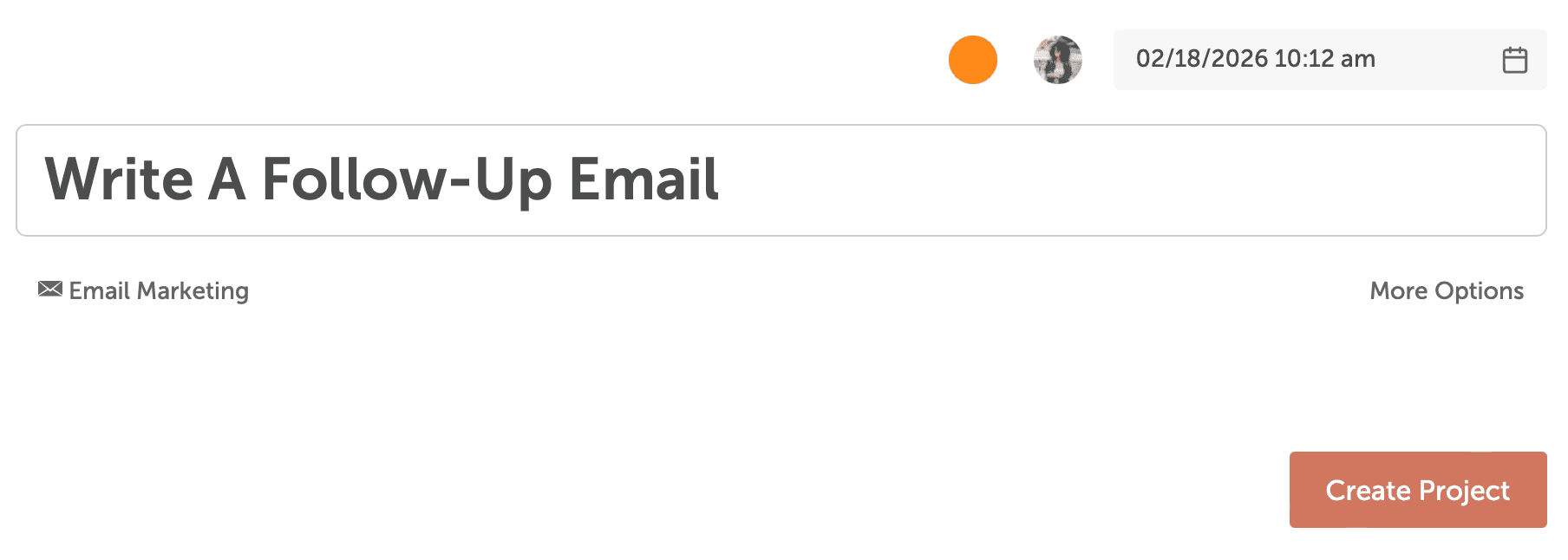
Step 2: Assign Tasks To Your Team
Begin by assigning tasks to delegate work for this project to specific team members.
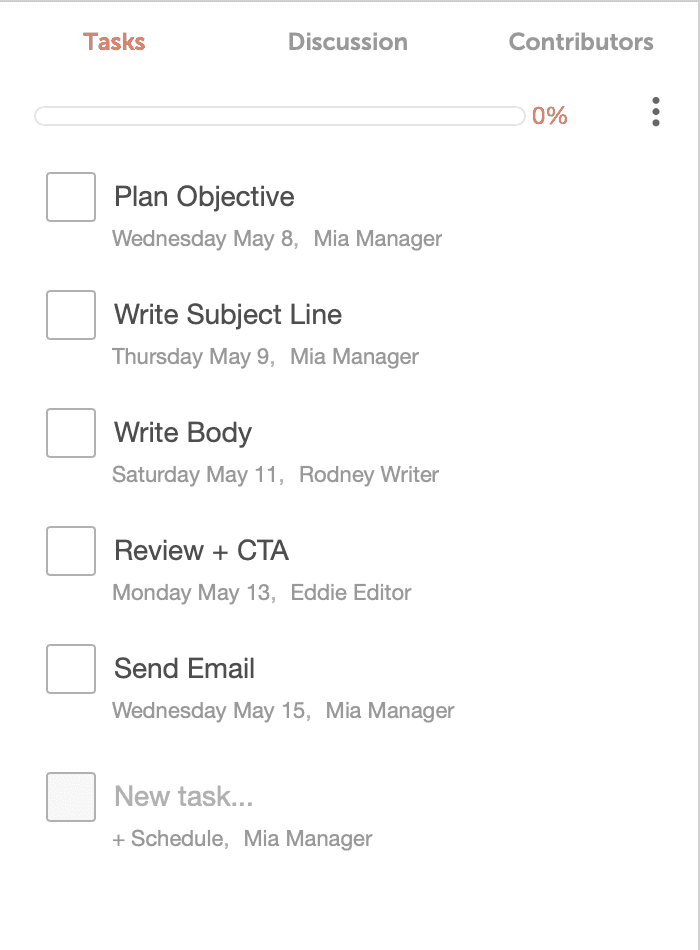
- Plan Objective
- Write Subject Line
- Write Body
- Review + CTA
- Send Email
When you assign tasks to a team member, they will automatically appear on their calendar.
Pro Tip: CoSchedule Marketing Calendar allows you to easily access a variety of
integrations, so you can continue to do your best work with your favorite tools.
Step 3: Save As A Task Template
Once you’ve defined your process for writing emails, save that process as a reusable Task Template. This will save you time the next time you need to assign an email project to your team.
To save your current task list as a Task Template, click the vertical ellipsis in the upper right hand corner of your taskbar, click “Task Template” then “Save Existing”. You can now access (and edit) that Task Template by selecting it from the list of Task Templates.
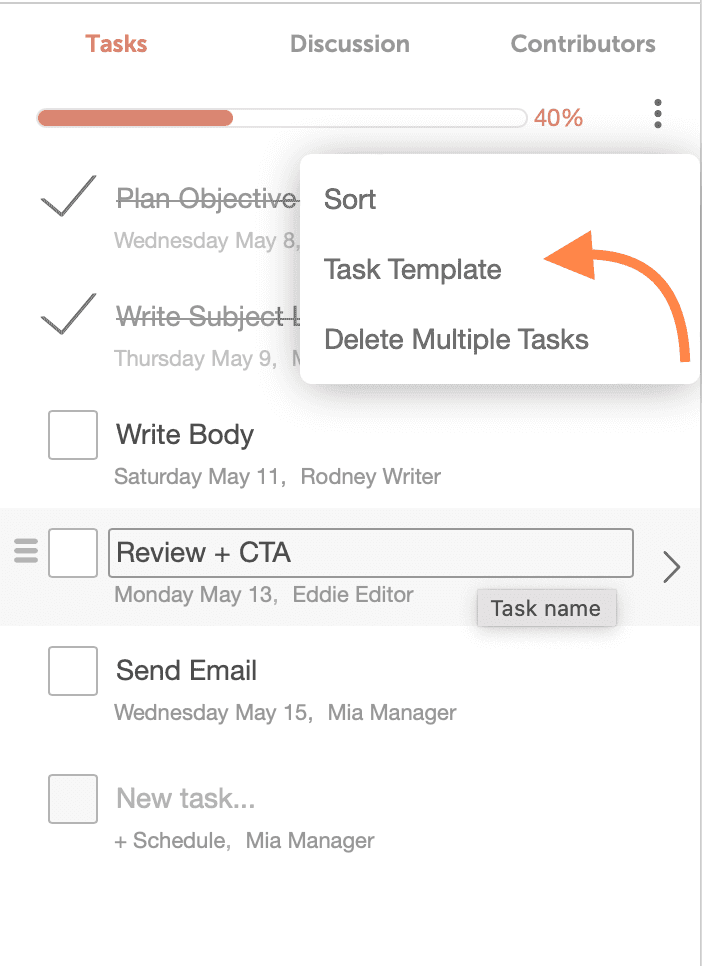

Now that you’ve saved these tasks as a task template, the next time you find yourself writing a follow-up email, you can quickly add and assign the tasks.
Step 4: Write A Subject Line That Converts
Create a powerful subject line that generates more opens. If your project falls into Email Marketing, CoSchedule’s
Email Subject Line Tester will automatically be there for you to use.
This tool provides feedback backed by data in seconds, so you can trust you’ve written an attention-grabbing subject line.
When attaching a document, you can start a new Google Doc or attach the current document by clicking the “Select Document” option.
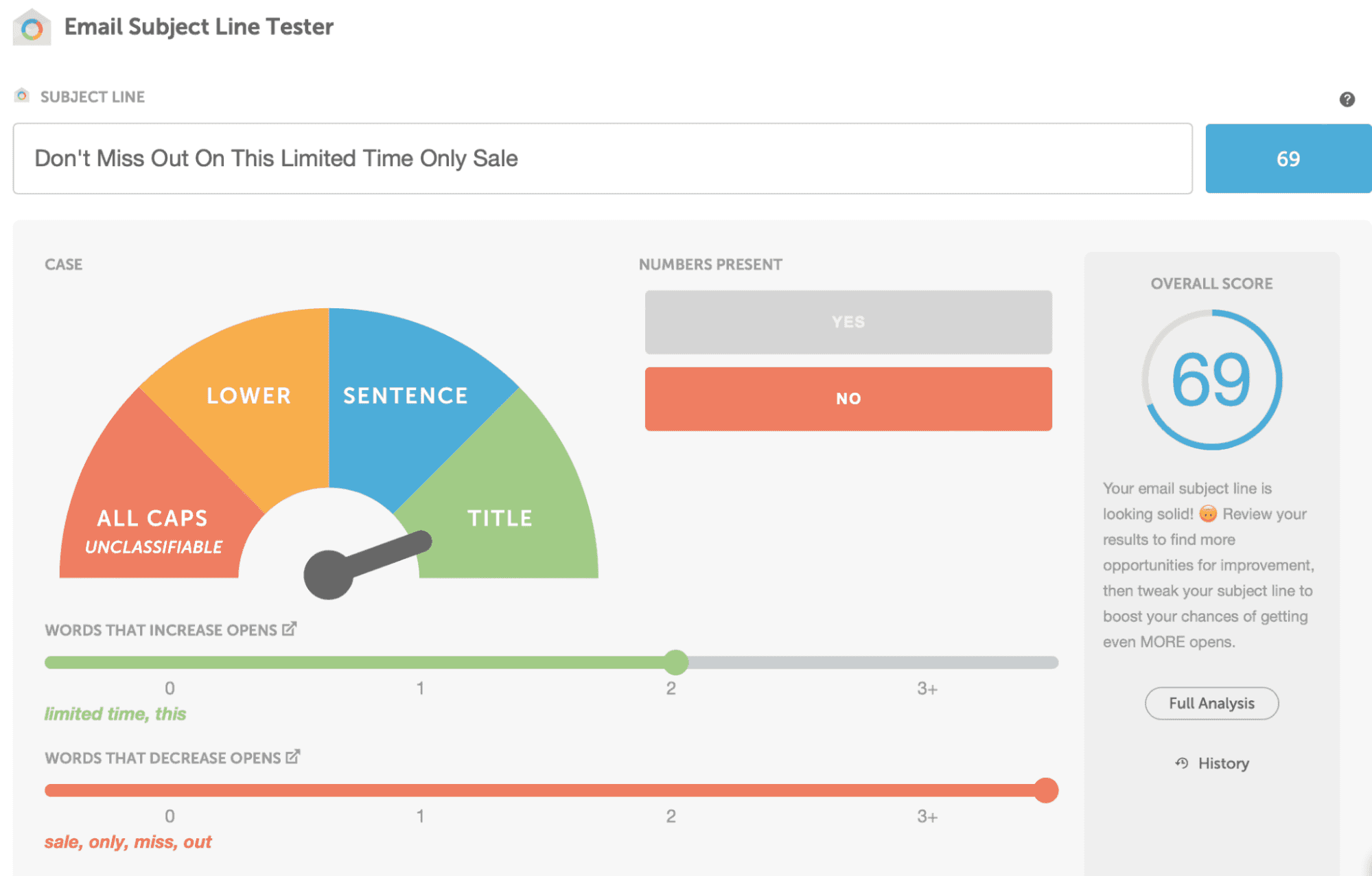
Step 5: Draft Your Email
Seamlessly begin drafting the body of your email. You can choose to manage the draft of your email in the text editor box at the top of the page, or arrow down to
attach a document.
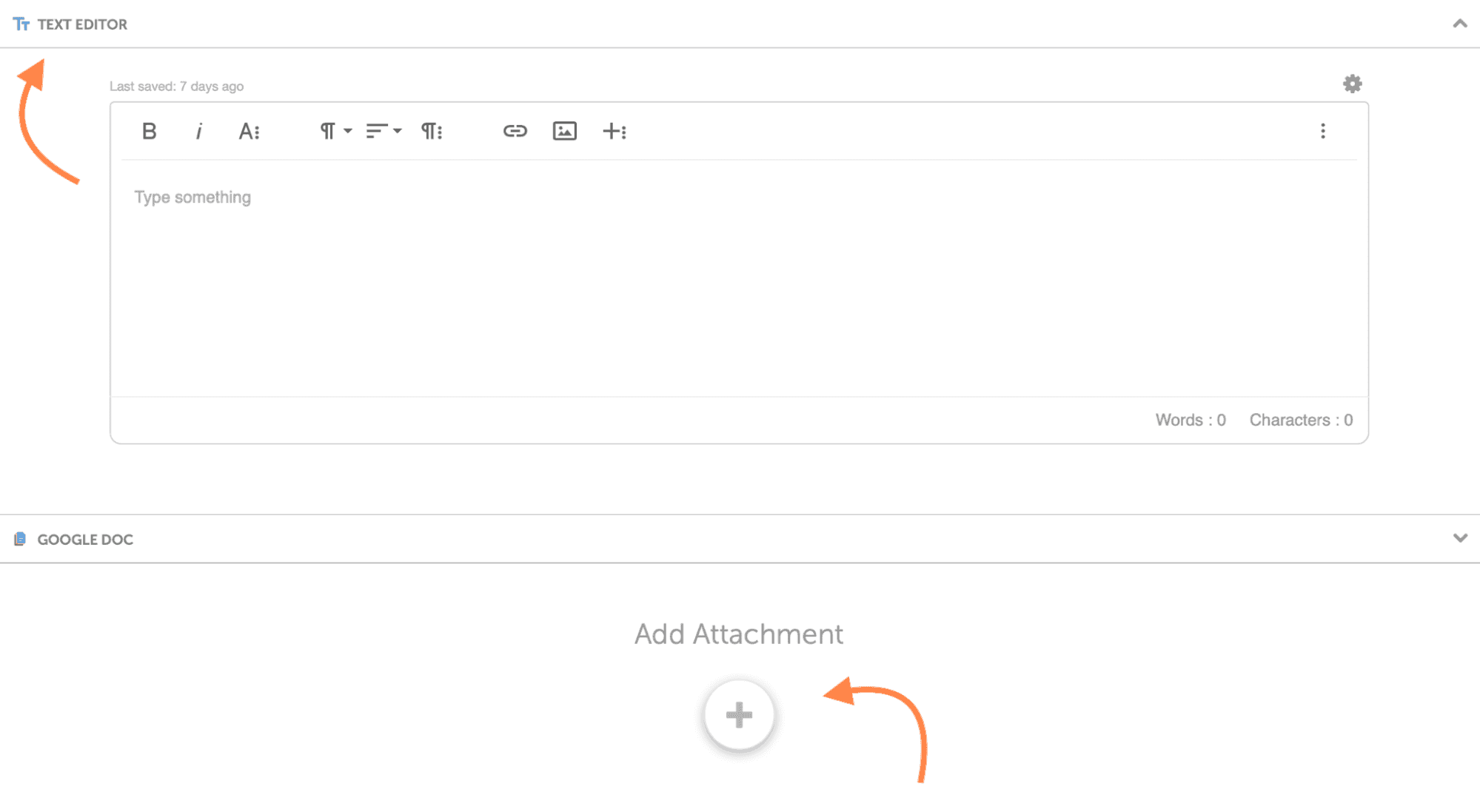 When attaching a document, you can start a new Google Doc or attach the current document by clicking the “Select Document” option.
When attaching a document, you can start a new Google Doc or attach the current document by clicking the “Select Document” option.
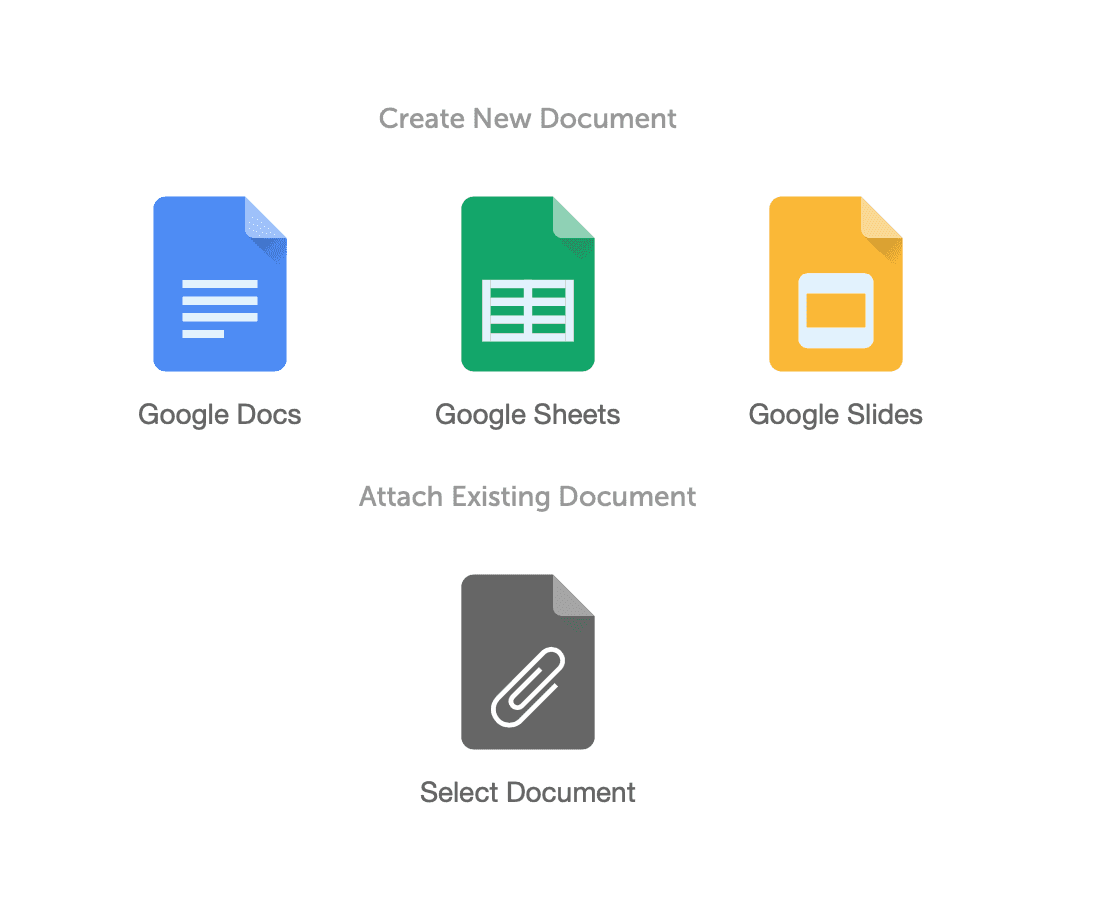
Step 6: Review With Your Team
Without hesitation, you and your team can work together to review the draft.
Use the Discussion feature to communicate with your team and avoid lost emails or miscommunication.

Step 7: Proudly Send Off Your Finalized Email
Give yourself a pat on the back for writing a flawless follow-up email. Completing the entire process at an arm’s length right in the project.
Now you’re equipped with everything you need to tackle follow-up emails with confidence and efficiency!
8. Second Time's A Charm
While the first follow-up email is effective, be prepared to send more than one follow-up email as part of your
email outreach campaign. Studies
reveal the optimal number is between two and three, and the fact that
44% of reps give up after just one follow-up can give you a serious competitive edge.
Here’s an emailing cadence that has worked out for us at CoSchedule:
- Day 1: Send the first email.
- Day 3: Send follow-up email #1.
- Day 7: Send follow-up email #2.
- Day 14: Send follow-up email #3.
- Day 21: Send follow-up email #4.
We generally recommend stopping after the fourth email, but depending on the prospect or lead, we may suggest a follow-up after two weeks or a month.
That’s everything you need to navigate through the treacherous peaks of inboxes and the daunting valleys of unanswered messages to achieve follow-up email greatness.
Go ahead, start following up, and convert those prospects!
 The initial email makes a polite introduction when you’re trying to get something done, whether it’s closing a deal or collecting information. And while it's important, it isn’t the whole story.
Recommended: Email Address Generator
That’s where follow-up emails come into the picture. You can send them to:
The initial email makes a polite introduction when you’re trying to get something done, whether it’s closing a deal or collecting information. And while it's important, it isn’t the whole story.
Recommended: Email Address Generator
That’s where follow-up emails come into the picture. You can send them to:


 As you can see, compared to the previous follow-up emails we shared, this one doesn’t provide any additional information to spark the recipient’s interest and get them to reply. It’s lazy.
Think about it: would you reply if you have hundreds of other things to do on your to-do list?
Exactly.
That’s why you should follow up an engaging opener with an equally amazing, value-packed email body.
Be specific and straightforward about your intentions so the reader doesn’t feel you’re wasting their time. Then use the following ideas to add value to your message:
As you can see, compared to the previous follow-up emails we shared, this one doesn’t provide any additional information to spark the recipient’s interest and get them to reply. It’s lazy.
Think about it: would you reply if you have hundreds of other things to do on your to-do list?
Exactly.
That’s why you should follow up an engaging opener with an equally amazing, value-packed email body.
Be specific and straightforward about your intentions so the reader doesn’t feel you’re wasting their time. Then use the following ideas to add value to your message:

 The sender makes it easy for the reader to respond and leaves a communication line open, which helps you stay connected and build relationships.
Here are some tips you can use to write similarly strong CTAs:
The sender makes it easy for the reader to respond and leaves a communication line open, which helps you stay connected and build relationships.
Here are some tips you can use to write similarly strong CTAs:

 Coschedule’s Marketing Calendar is built to coordinate all of your marketing projects. Maximize potential in your emails using the Marketing Calendar. Ensure your finished email will stand out and accomplish what it’s intended to.
Coschedule’s Marketing Calendar is built to coordinate all of your marketing projects. Maximize potential in your emails using the Marketing Calendar. Ensure your finished email will stand out and accomplish what it’s intended to.
 Choose an email project, add a color tag to highlight the purpose of the email, and schedule a set date for when you would like to send your follow-up email.
Choose an email project, add a color tag to highlight the purpose of the email, and schedule a set date for when you would like to send your follow-up email.



 Now that you’ve saved these tasks as a task template, the next time you find yourself writing a follow-up email, you can quickly add and assign the tasks.
Now that you’ve saved these tasks as a task template, the next time you find yourself writing a follow-up email, you can quickly add and assign the tasks.

 When attaching a document, you can start a new Google Doc or attach the current document by clicking the “Select Document” option.
When attaching a document, you can start a new Google Doc or attach the current document by clicking the “Select Document” option.




